Thanks to John Durante at Laughing Buddha in Seattle for sending in this shot of a great looking set of microdermals (imagine something half way between a transdermal implant and a dermal anchor if you don’t already know the technique).

Thanks to John Durante at Laughing Buddha in Seattle for sending in this shot of a great looking set of microdermals (imagine something half way between a transdermal implant and a dermal anchor if you don’t already know the technique).

I’ve posted a few of these microdermals and dermal anchors lately. For those of you not up on the technology, it’s sort of half way between transdermal implants and single point pocketing. The strong advantage over transdermal implants is their non-invasive nature — no secondary incisions, sutures, or special tools are needed. Here’s a gorgeous titanium and blue opal example, outside and inside the body by James Wisniewski at Body Electric in Hollywood, CA.
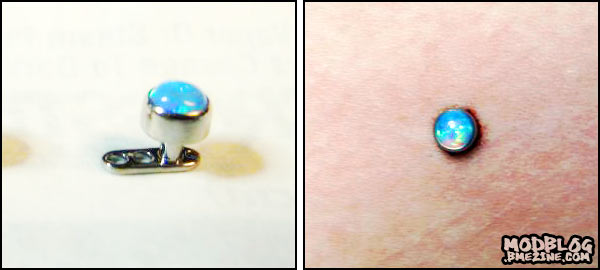
Check out these new “microdermals” (jewelry by JD) by John at Scarab in Syracuse, NY. My feeling is that transdermals, at least the current “labret clover” technology, have too low a success rate, so I’m very interested in dermal anchors like these (which even if they don’t have a higher success rate in the end, at least are easy to remove, unlikely to go toxic, and don’t leave a major scar).

I’m not sure if Thunvall chopped his luscious locks off for this photo but it is still an interesting juxtaposition from one side to the other.
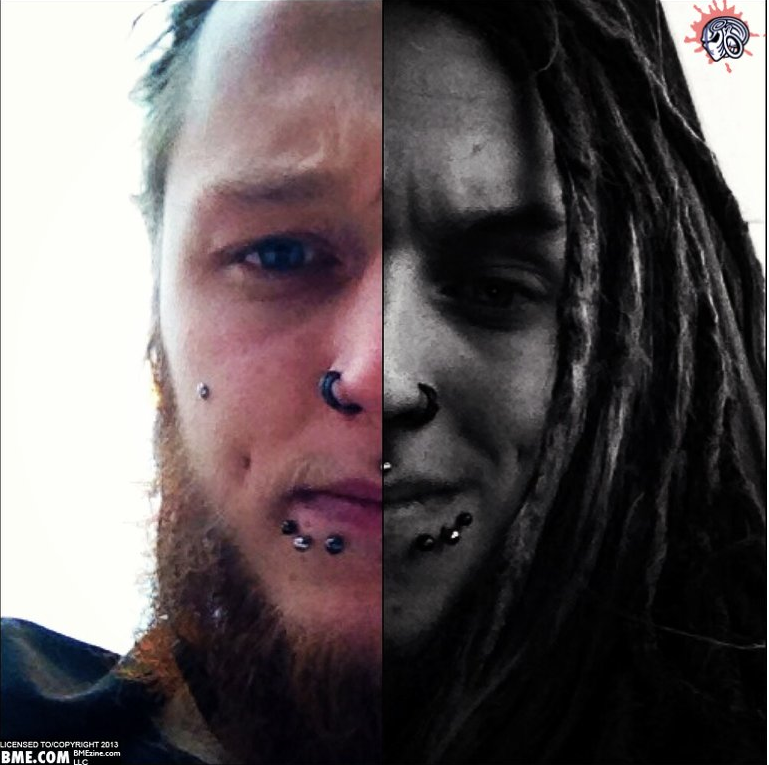 Either way I like the put together look and you know I’m a sucker for nice paired piercings! It might not seem like a huge body modification but I know from experience that chopping long hair off can feel as significant as a tattoo or piercing if not more.
Either way I like the put together look and you know I’m a sucker for nice paired piercings! It might not seem like a huge body modification but I know from experience that chopping long hair off can feel as significant as a tattoo or piercing if not more.
Here’s a good mod for people who really like the way hard nipples look under a tight t-shirt! These nipple microdermals were done by Matt who pierces at Everything & Nothing (everythingandnothing.co.uk) in Carlisle, Cumbria. I asked Matt about the difference between doing a microdermal on normal skin versus nipple tissue, and he filled me in with his experiences,
I found that the tissue that needed to be removed was stuck fast, and needed to be removed with haemostats rather than gently being wiped away with a swab (as with microdermals on the stomach or arm for example). The only thing I can compare it to is the back of the neck — tough and not a lot of room for moving it around once put in place. Insertion was very simple. I had freehand needles ready to place in at angles to help insertion but they were unnecessary. The jewellery slotted straight in and was perfectly flat the first time. They bled more than anywhere I’ve placed them before but not enough to give me reason to worry — it stopped after two minutes or so.
The customer, a forty-six year old body modification enthusiast from Nottingham had wanted these for a long time, but because of his work on the oil rigs hadn’t been able to get it until now. He described the procedure as painful, but on the other hand, the kind of guy that works the rigs doesn’t have a problem dealing with a little pain! Zoom in for a larger look.
On February 1st, 2008, Gabriele of Maxart Bodypiercing in Rome, Italy did a scalpelled nape procedure, and a year later it had healed nicely (as you can see in the left image below). A little redness and scarring around the edges (zoom in for a closer look), but almost none of the rejection or migration as is common with surface piercings done without surface-specific jewelry. By using a scalpel rather than a needle to create a large, non-destructive hole, big enough to form a “flap” that could sit comfortably over the jewelry without the jewelry putting pressure on the tissue above it, Gabriele avoided using something like a surface bar specifically designed to mitigate the pressures that lead to tissue dying off. Surface bars are great of course, but many people prefer the look of a ring to a pair of beads, especially in this age of microdermals. As you can see in the right two pictures, taken at five years after the piercing was done, it’s remained very solid long-term — and as the late Erl proved, piercings like this (his nape was almost identical) can last for decades.
You know I was thinking that with all the oohing and ahhing and freaking out over eyeball tattoos, we sometimes forget another modification which is almost equally rare and unusual, and far less likely to blind you — flesh staples. First invented by Samppa Von Cyborg in the late 1990s as an improvement on pocketing technologies, the technology is now mature and mass-produced flat-bar staples are available from Samppa (voncyb.org). This particular example was done by the folks at Calm Body Modification (calmbodymod.com) in Stockholm. In addition to the sideburn staple, I also very much like the unique microdermal placement.
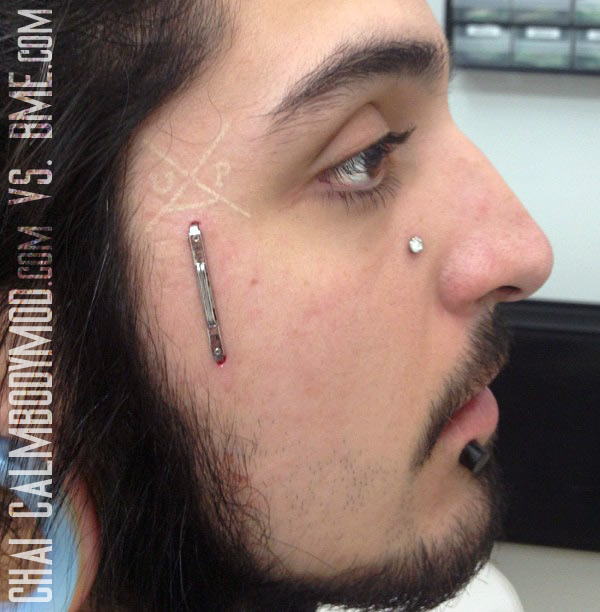
Edit/update — I wanted to add a longer shot to put it into context.
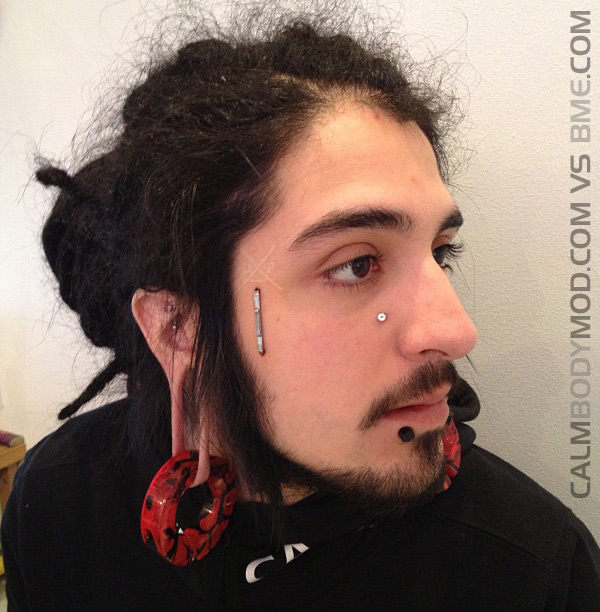
I think that’s how the old expression goes, right?
Ighlif Rendina, owner and piercer at H.F. Body Art in Turin, Italy, had a customer who’d previously gotten a transdermal implant. The transdermal itself did alright, but in time, a large unsightly scar built up over the insertion incision. The microdermal was removed, and the scar reworked using a combination of cutting and cautery branding. The insertion scar became the pupil of the eye, and the scar that formed in the transdermal scar was covered up by the bottom line of the eye. In the picture where you can see the entire eye, it’s quite fresh, about two months after being done, and the picture where it’s partially covered by clothing is current, showing the piece at almost two years old.
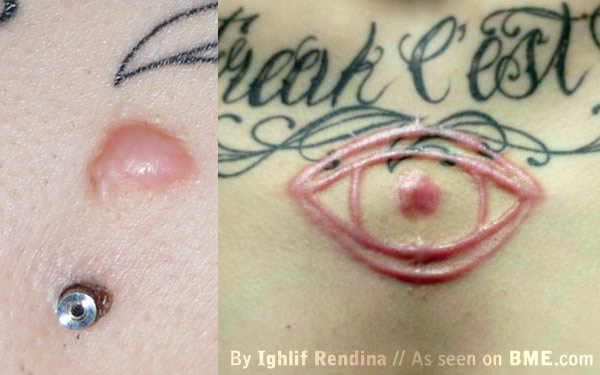
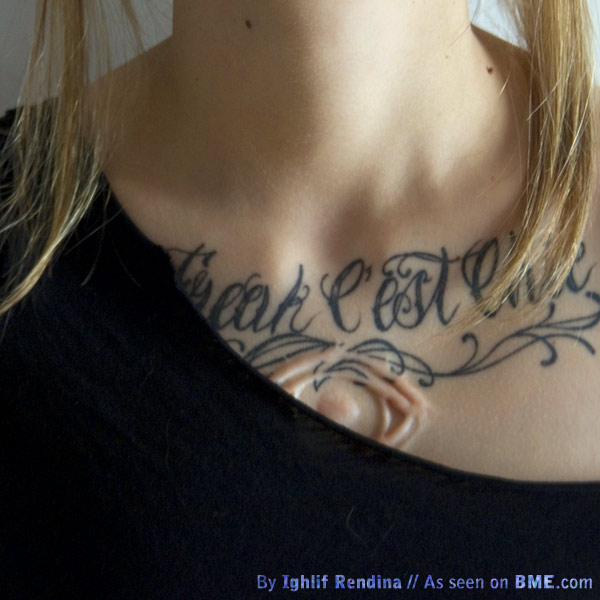
I’m not sure what I should call this microdermal project by John Danger Alonzo of Superstition Tattoo (superstitiontattoo.com) in Massapequa, NY… Since I don’t have a good name for it, I’ll just leave that as “a big question mark” for now. Har har har.
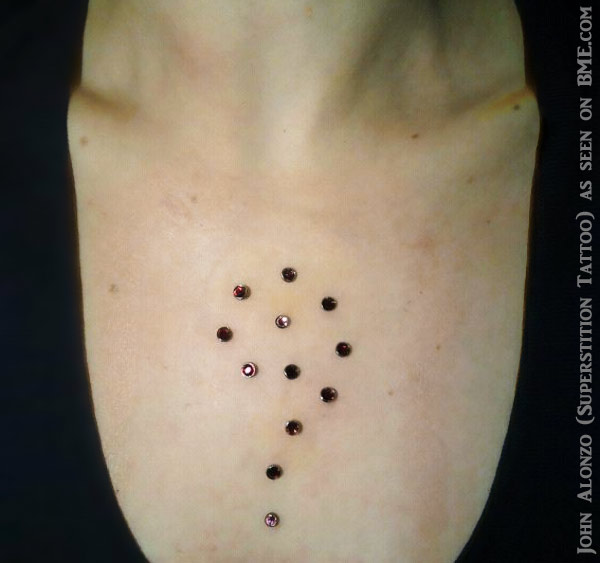
This isn’t really an implant of course — it’s a cross that’s been semi-permanently mounted on the wearer’s chest using three microdermals to hold it in place. Christopher Lee Shelafoe of Marquette, MI’s Rendezvous Tattoo & Body Piercing (I recently featured an anarchy scar he did) is who installed it, said that in an ideal world he would have like to use a lighter cross, but the client specifically needed that exact cross because it had belonged to his child. So they did it as best they could, with the understanding it was an experiment. It was still in place last time he spoke with the wearer, who has since moved away. Christopher and I were talking about how he’d tackle this next time, and he’s working on having microdermals mad with magnetic ends so that the cross (or whatever) can be solidly mounted, but will pop off without injury if it gets snagged.
